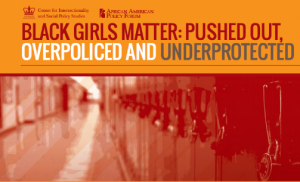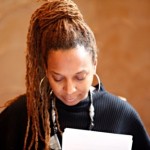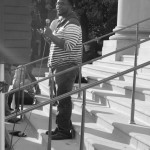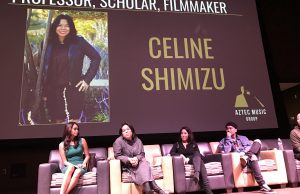“Black Girls Matter”: An Interview with Kimberle Crenshaw and Luke Harris
By Ahmad Greene-Hayes
On Wednesday, February 4, 2015, the African American Policy Forum (AAPF) released its groundbreaking report, “Black Girls Matter.” Ahmad Greene-Hayes, a guest writer for The Feminist Wire, interviews Dr. Kimberlé Crenshaw and Dr. Luke Harris, from AAPF, about this report’s impact on the Black Lives Matter movement. The report, executive summary, and social media guide are also available online for viewing.
Ahmad: The African American Policy Forum has been an instrumental voice in the national dialogue centered on the inclusion of girls in racial justice policies and initiatives. Your work was pivotal in shaping the conversation on the limitations of President Obama’s My Brother’s Keeper initiative. Outside of the work AAPF has been doing, what was the genesis of Black Girls Matter: Pushed Out, Over-policed, and Under-protected?
Kimberle: The genealogy of this study began several years ago when I, along with one of the Report’s co-authors, Priscilla Ocen, began a conversation with formerly incarcerated women, advocates, lawyers and service providers on the conditions that result in poor life outcomes for Black women and other women of color. We were especially concerned about the gendered pathways to confinement that seemed to be so prevalent in the lives of many Black women, but relatively absent in the public discussion about the school to prison pipeline and mass incarceration.
That dialogue grew into a conference organized with our third co-author, Jyoti Nanda, about how gender, race and class function together to create the context for the disproportionate criminalization of women of color.
We knew that many of the long term challenges facing Black women and girls are correlated with the failure to complete school, so we wanted young girls to tell us their stories in their own words. In this sense, Black Girls Matter provides a snapshot of the conditions that confront Black girls in two of our nation’s school districts – New York and Boston. It draws attention to the ways in which educational policies and other societal factors contribute to the tenuous relationship that girls of color have with their schools.
Utilizing data disaggregated by gender and race, the report describes the racial disparities that Black girls face relative to white girls as well as to boys of color. By lifting up the stories of Black girls, we hope to convince policy makers and the public at large that girls of color face serious challenges that need to be addressed and addressed now.
Ahmad: You write, “Black Girls Matter: Pushed Out, Over-policed, and Under-protected seeks to increase awareness of the gendered consequences of disciplinary and push-out policies for girls of color, and, in particular, Black girls.”
How has the contemporary Black liberation movement, after increased attention to blue-on-Black violence in response to the deaths of Trayvon Martin, Michael Brown, Jr., Tamir Rice and so many other Black boys, intensified the need for this report?
Luke: It is heartening to see such a strong resurgence of the racial justice movement. But, it was not an accident that we decided to title our report “Black Girls Matter.” As the movement draws attention to the deaths of Black men and boys, the deaths of women and girls in our communities remain on the margins of the conversation. This movement, however, has extraordinarily strong, vibrant, and visionary female leadership — women who recognize the need to develop a genuinely inclusive vision of racial justice. So they are well positioned to help us learn to talk about not only state violence, but violence in our homes and communities; to push men of color to be much more introspective about the ways in which we enjoy patriarchal privilege in American society; and to work to ensure that the movement targets the full array of concerns that plague the Black community.
At the end of the day, we have to be as concerned about the experiences of single Black women who raise their kids on welfare as we are about the disproportionate number of Black men who are incarcerated. We must care as much about Black women who are the victims of domestic violence as we do about Black boys caught up in the drug trade. We must emphasize the fact that Black women on average make less money and have less wealth than both white women and Black men in the United States as much as we focus on the ways in which Black men (and women) are disproportionately excluded from many traditional professions.
If the Black community walks down this path, we can reshape our rhetorical understanding of what it means to be an endangered Black person in a way that embraces the experiences of both boys and girls; and we can pursue a cosmopolitan vision of racial justice that embraces all of us.
 Ahmad: As someone who mobilizes against sexual violence in Black communities, I was struck by the evidence of sexual harassment and sexual abuse experienced by Black girls in schools, and by the lack of protection offered by school administrators and school districts.
Ahmad: As someone who mobilizes against sexual violence in Black communities, I was struck by the evidence of sexual harassment and sexual abuse experienced by Black girls in schools, and by the lack of protection offered by school administrators and school districts.
Do you think college and university rape policies are mirroring the ways sexual violence, involving Black girls, is handled in grades K-12?
Kimberle/Luke: Without question there is a need for greater sensitivity in both contexts. The problems for Black girls, however, are exacerbated by racial stereotypes. In the Black community, we often don’t even see rape and sexual harassment as Black on Black crimes. In fact, we sometimes avoid talking about these issues out of a fear that to speak of such matters would be to fuel and encourage destructive racial stereotypes about Black men. This fear, more often than not, tends to minimize the importance of these issues. Yet, according to Black Women’s Blueprint, close to sixty percent of Black girls have experienced sexual abuse before reaching the age of 18; and other researchers have documented that Black girls are much more likely to be the victims of sex trafficking than their white counterparts.
It is absolutely necessary that the devaluation of these concerns and the tremendous impact that they have on girls in our community be acknowledged and remedied. Our report, among other things, is designed to call attention to these problems and to earmark them as important racial justice issues.
Ahmad: On page 32 of the report, you feature the following words from a Black girl, “[I]f no one is celebrating with [you], then you kind of fade and then you have that other alternative culture that is waiting for you where you will be celebrated. . . . [When] you realize that you will be celebrated if you are a well-known figure of prominence in the school for something else, then you kind of go in that direction and then it’s kind of a spiral.
In the aftermath of the My Brother’s Keeper Initiative and the racist murders of Aiyana Stanley-Jones and Renisha McBride among so many Black women and girls, in what ways have Black organizing bodies failed Black girls?
Kimberle/Luke: We have failed Black girls when their experiences are not centered at the core of our vision of racial justice. We have failed them when we resist empowering women as core leaders of our organizations. We have failed them when we subject them to catcalling and other forms of sexual harassment on the front lines of protests against racialized violence. We have failed them when we applaud their work in these settings, while marginalizing them in the corridors of power behind closed doors.
We have also failed them when we encourage or force them to choose between their gender and their race; and when we question their loyalty to the race when they raise feminist issues rather than working with them to erase the roadblocks those concerns represent. So what has to happen?
We have to be honest and frank about the realities of the lives of Black women and girls and work to build capacity among policy makers, stakeholders, allies, and funders so that they are empowered to construct nurturing environments within which our girls can succeed. Simply put, we have to come to terms with the reality that women and girls must be at the heart of our racial justice agenda right alongside the boys.
 Ahmad: Historically and contemporaneously, as your report shows, Black girls are treated and seen as women and mothers in their family, and in some regards, as surrogates for siblings. In what ways must local, state and national policy address non-traditional, non-nuclear, and alternative Black familial structures? In what ways can we reverse the trend such that Black girls have a right to childhoods and not be so easily pushed into adulthood?
Ahmad: Historically and contemporaneously, as your report shows, Black girls are treated and seen as women and mothers in their family, and in some regards, as surrogates for siblings. In what ways must local, state and national policy address non-traditional, non-nuclear, and alternative Black familial structures? In what ways can we reverse the trend such that Black girls have a right to childhoods and not be so easily pushed into adulthood?
Kimberle/Luke: Black girls are placed in these untenable positions because they are assumed to be the principle caretakers in our community, the ones who will and must sacrifice everything for the sake of the family even if their own needs and dreams must go unrealized. Often their parents are burdened with overwhelming responsibilities in a society where the social welfare system leaves much to be desired and the children, especially the girls, are left to pick up the pieces.
In this setting, there is a commonly accepted argument that the problems within Black communities principally result from absent fathers. But, this shortsighted and wrong-headed perspective actually devalues the women who are present, supporting and fighting for our families. So, we need to genuinely take stock of their situation rather than impose falsely moralistic norms onto these young people. Rather than disproportionately focusing corporate and philanthropic resources on men and boys in settings where all Black people confront serious institutional barriers, we should strive to promote large scale innovative initiatives that focus on the needs of both boys and girls.
Some of these needs will parallel one another. Others will be demonstrably different. For example, a well conceived broadly based vision of racial justice should embrace the need for adequate health care measures and childcare for teen mothers. It should increase support for girls sexually abused in and outside of school. It should heighten awareness of what constitutes sexual harassment and what it takes to effectively eliminate it. But, in no way should it endorse the idea that the nuclear family represents the only healthy family formation in modern America.
Ahmad: Why is it so hard for the Black community to mobilize around the suffering of Black women and girls. For example, the lack of outcry for the deaths of slain Black cis and trans women and girls, or the rapes of Black women and girls by police, such as in the case of Oklahoma Officer Daniel Holtzclaw?
Luke: It’s so hard because, more often than not, we have assumed that racism harms Black men more than it does Black women. For a long time, I too bought into the belief that Black boys and men needed more help, more programs, and more interventions. I too believed that lifting us up would somehow solve the Black community’s problems as a whole. In the process, I lost sight of the challenges I saw my own mothers confront on a daily basis. As their son, I had not only failed to understand how their health, wealth and security affected my future, I had completely disregarded how their dreams for themselves might have been more richly nurtured and supported had I embraced a vision of racial justice that centered their concerns as well as those of my father. So what must we do?
We know that both African American boys and girls confront serious racial barriers – including failing schools, unwarranted forms of criminalization and impoverished communities. We know that compared to all girls Black girls have the worst rates of suspension, juvenile detention, and homicide. Moreover, we know that the gender specific ways in which they experience sexual harassment, teen pregnancy and other familial burdens are seldom focused on in the quest for racial justice. So moving forward we must target these issues because they are central to developing the systematic and structural solutions necessary to dismantle the obstacles that Black girls face on a day-to-day basis.
Institutionalized racism affects all Black Americans; and Black girls are in crisis too. It is as simple as that.
For these reasons, we believe we need a new frame of reference for understanding racial inequality. The frame we envision is grounded in Black feminist values and is intersectional in nature. It’s a frame that attends to issues of gender, race, and class as well as other socially constructed identities. In its most sophisticated iterations, this lens sheds light on the complex ways in which systemic forms of subordination can circumscribe opportunities for the members of marginalized groups in distinct and extraordinary ways; and without question this framework has the capacity to help us to reimagine and concentrate the needs of Black women and girls at the heart of our vision of racial justice.
Ahmad: As Black feminist scholars, do you have any recommendations for how Black girlhood studies should be shaped following this report? And what would you note are areas still left to explore?
We believe that we must resist a patriarchal sensibility that regards the ways that Black girls are disadvantaged as girls as largely unremarkable, while at the same time deeming all of the ways in which Black boys are disadvantaged as boys as uniquely problematic. In fact, we categorically reject this perspective. In the alternative, we advocate for studies that are sculpted to the contours of the lived experiences of all of the members of our community.
We know that research on Black girls and other girls of color is under-resourced, and under-acknowledged when it enters the public domain. We know there is a need to develop both qualitative and quantitative data that examines the historical and social roots of the problems that continue to plague communities of color in the United States. We also know that we need to produce disaggregated data that explores issues of sameness and difference both across racial groups and within them if we are to truly discern how girls of color are faring in the world. So we promote research designed to reveal pathways towards economic stability and optimal life chances for girls of color.
Our study was a critical first step, but it was limited in scope. Black Girls Matter focused on girls in the New York City and Boston public school systems. Going forward we would like to see reports undertaken in other cities and states across the nation. There is a need to develop more data that embraces the ways in which gender and race discrimination affect trans and gender nonconforming girls, girls of color outside the Black community, and girls with disabilities. In gist, research on school discipline, push-out, and the pathways to underachievement, low-wage work, poverty, and incarceration should include all youth of color, not just boys and young men.
A significant amount of data has already been disaggregated by gender and race to highlight the experiences of boys of color. We need to both develop and assess more data on women and girls, and to pay much more attention to the research we have already amassed on them. If we do these things, we can then promote a truly grand vision of racial justice — one that actually leaves no child behind, and that speaks eloquently to the lives of all of us.
****************************************************************************
 Kimberle Williams Crenshaw, Executive Director of the African American Policy Forum & Professor of law at both the Columbia and UCLA Law Schools.
Kimberle Williams Crenshaw, Executive Director of the African American Policy Forum & Professor of law at both the Columbia and UCLA Law Schools.
 Luke Charles Harris, Program Director of the African American Policy Forum & associate professor of American Politics and Constitutional Law at Vassar College.
Luke Charles Harris, Program Director of the African American Policy Forum & associate professor of American Politics and Constitutional Law at Vassar College.
 Ahmad Greene-Hayes is a student at Williams College, currently participating in a Visiting Scholars’ Program at Columbia University in the City of New York. His research, as a Mellon Mays Undergraduate Fellow, examines gender-based, racial-sexual violence from Civil Rights to Black Power to our contemporary moment. He is also a community organizer and freelance writer working with Black Lives Matter.
Ahmad Greene-Hayes is a student at Williams College, currently participating in a Visiting Scholars’ Program at Columbia University in the City of New York. His research, as a Mellon Mays Undergraduate Fellow, examines gender-based, racial-sexual violence from Civil Rights to Black Power to our contemporary moment. He is also a community organizer and freelance writer working with Black Lives Matter.




Pingback: The Unacknowledged History of Women of Colour | twobillionrising